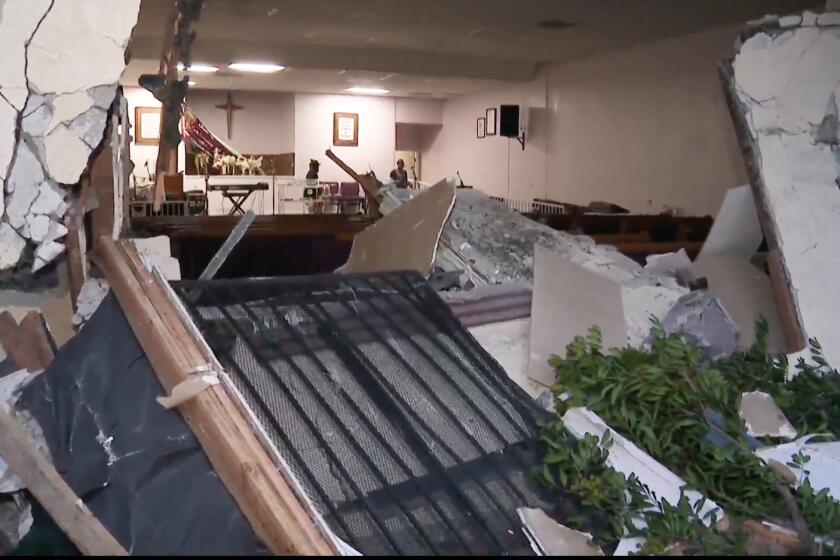New, Stricter Standards May Limit Use of Underground Water
Stricter standards of water purity raise doubts whether the Southland will be able to make full use of a major water source--its vast system of natural underground reservoirs--a Southern California Metropolitan Water District report warned Monday.
The report emphasized that water provided to consumers in the MWD area--Ventura, Orange, Los Angeles, Riverside, San Bernardino and Riverside counties--”is of high quality and continues to meet all drinking water quality standards.”
But district experts said that higher standards, the probable result of revisions of the federal Safe Drinking Water Act and California voters’ approval of Proposition 65, make the future acceptability of all underground water supplies “less certain.”
The report also said that while the impact of toxic chemicals is “minimal so far, implications of organic chemicals on future ground water supply are uncertain and ever-changing as new standards are established, as constituents now in . . . water or in the soil continue to migrate and as new compounds that are identified as potentially hazardous are found in water supplies.”
Demand for Northern Supply
The need to reduce underground water uses is likely to increase the pressure to import more water from Northern California, which is reluctant to give it up.
Especially affected, the report said, is Riverside County, where agricultural land, which uses mineral-heavy well water for irrigation, is rapidly being converted into residential areas, which require much more pure drinking water.
In Orange County, tests of 54 key water wells in the Orange County Water District basin last year turned up traces of organic pollutants in 12 wells, district officials have said. Although none of the trace pollutants were considered hazardous, the application of the stricter standards raises concerns for the future.
The district serves about 1.9 million residents living over the basin encompassing most of northern, western and central Orange County. Seventy percent of the drinking water comes from ground water supplies. The remainder is purchased from MWD.
A leak of 37,000 gallons of gasoline at a Mobil Oil distribution terminal has forced the closure of at least one well in the Anaheim municipal water district because traces of hydrocarbons were detected in monitoring wells a few miles away.
Smaller wells in the Anaheim area and elsewhere have been closed because high levels of solvents were found, forcing water users to go to bottled water supplies until they were able to hook up to a different system.
Despite its mild wording, one MWD committee on Monday delayed action on the report and another’s members took issue with some of its findings.
The district’s general manager, Carl Baronkay, said that some committee members expressed concern that the public would be unnecessarily alarmed by a part of the report.
The reception of the report by board committees appeared to reflect an ambivalence by at least part of the board and some MWD managers toward demands by environmentalists for stricter water purity standards.
The board, following the advice of its staff, had voted to remain neutral on Proposition 65, which was designed to stop the release of cancer-causing chemicals into the state’s drinking water supply.
The report comes as a state body, the Regional Water Quality Control Board, prepares to discuss later this month a plan to launch an investigation of contamination of underground water supplies in the Los Angeles area.
Current Standards Discussed
The MWD report dealt with these vast reservoirs of water beneath the ground. Water experts call it ground water.
The report said only a small amount of the ground water reaching the water supply fails to meet current standards. “Ground water quality concerns have reduced local water supply by about 80,000 acre-feet per year,” it said.
An acre-foot is the amount of water required to cover an acre to a depth of one foot.
More than 90% of this contamination is from natural minerals in the soil, including saltwater intrusion into coastal underground water supplies. The rest is from toxic chemicals, which when discovered leads to the closing of wells.
Concern for Future
Water experts say that the new and important portions of the report are the sections drawing attention to the future.
The report said that failure to meet present and new water quality standards may disrupt plans to store water from Northern California in the natural underground reservoirs of San Bernardino’s Chino Basin. That is because of the danger of pollution to these reservoirs.
That storage concept is at the heart of present plans to persuade Northern California to send more of its water south. Water officials have proposed that large amounts of water be sent south during wet years and stored underground. That would permit a halt to water shipments from the north during dry years.
Such an arrangement, water officials have said, would leave Northern California with enough water to assure the quality of its own supplies, particularly those in the Sacramento-San Joaquin Delta, a fishing and agricultural area often hard hit by southern water shipments.
More to Read
Start your day right
Sign up for Essential California for news, features and recommendations from the L.A. Times and beyond in your inbox six days a week.
You may occasionally receive promotional content from the Los Angeles Times.





